Thinking about skiing for the first time and have a laundry list of questions? Like, where are the best places to ski as a first-timer? What type of gear do I need for skiing? Should I book a ski lesson before hitting the slopes on my own? These are questions I wish I had thought to ask before skiing for the first time. Instead, I made assumptions, and I assumed completely wrong. So, if you’re thinking about these questions, and have come across this blog post, then you’re already on the right track.
I want you to be better prepared than me, so I’ve created this list of things you should know before skiing for the first time. Strap in because we’ve got 30 game-changing tips that will turn you into a skiing pro in no time, discussing everything from what to wear to what to expect as a first-time skier. Let’s dive in and make sure your first time on the slopes is nothing short of epic!
There may be some affiliate links in this blog post. That means if you click and make a purchase, I may earn a small commission at no extra cost to you. Thanks for supporting the blog!
Where to Ski for the First Time
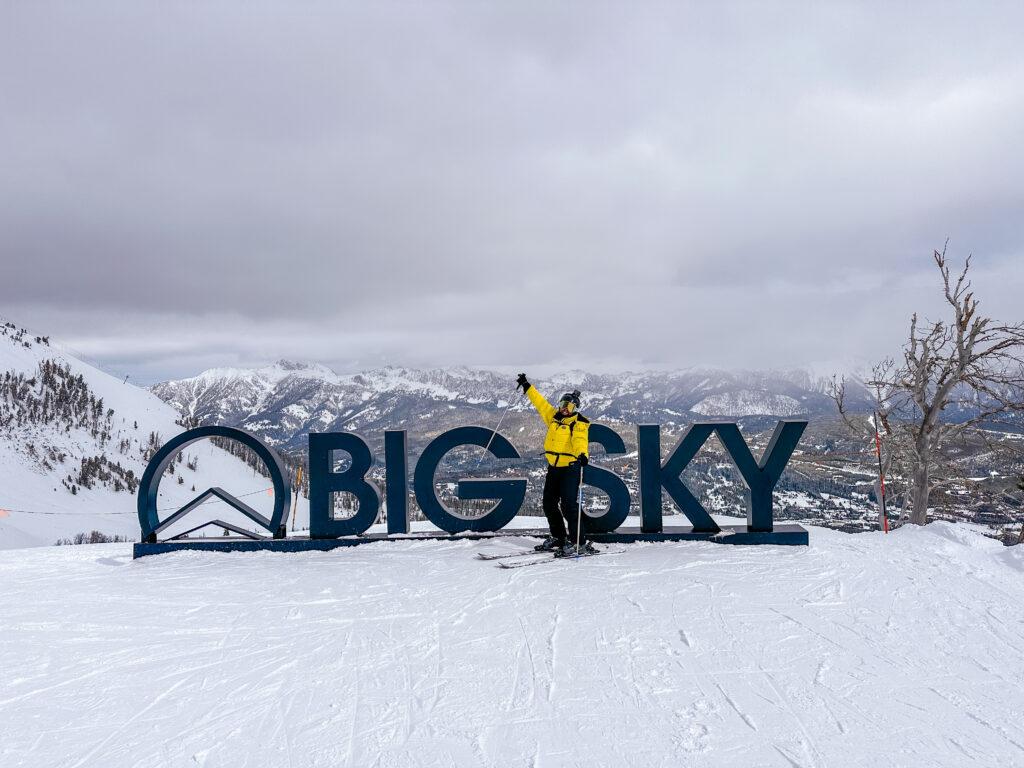
My first time skiing was on the slopes of Jahorina Mountain, the location of the 1984 Winter Olympics in Sarajevo, Bosnia and Herzegovina. Ummm…intimidating much?! While there are awesome places all over the world with amazing slopes, the U.S. has some epic snow-covered peaks of its own that are perfect for first-time skiers.
Best Places to Ski in the U.S. for Beginners
Vail, Colorado:
Why Vail? It’s iconic for a reason! Vail boasts not only stunning views but also dedicated beginner areas and world-class instructors. Get ready to fall in love with skiing amidst the breathtaking Rockies.
Snowmass, Colorado:
Why Snowmass? A part of the Aspen Snowmass resort, Snowmass offers wide, gentle slopes perfect for beginners. It’s a snowy playground with a laid-back vibe – ideal for honing your skiing skills. Snowmass is a personal favorite of mine!
View this post on Instagram
Big Sky, Montana:
Why Big Sky? As expansive as its name suggests, Big Sky provides a welcoming environment for beginners. Picture yourself gliding down the slopes with the vast Montana sky above – it’s a scene straight out of a winter fairy tale. Big Sky is also the upcoming location of the 2024 National Brotherhood of Skiers annual event. Black snowsports enthusiasts will gather for a week filled with winter sports fun.

Click here to Check out these unmissable things to do in Big Sky in winter
Park City, Utah:
Why Park City? Renowned for its charm and accessibility, Park City is a gem for first-timers. Mix easy slopes with a vibrant après-ski scene, making it the perfect all-in-one destination.
Breckenridge, Colorado:
Why Breckenridge? Breck, as the locals call it, combines iconic peaks with a dedicated learning area for first-timers. It’s a town where history meets winter sports, creating a magical atmosphere.
Lake Tahoe, California/Nevada:
Why Lake Tahoe? Straddling two states, Lake Tahoe offers a variety of resorts with beginner-friendly slopes. Enjoy the sparkling blue lake as your backdrop while you perfect your turns.
10 things to know before skiing for the first time
1. CYA: Get Travel Insurance
So, you’ve locked in your destination, booked the flights, and secured your hotel/lodge for your big ski adventure. But, have you covered your a** (CYA), literally? Accidents can happen with any sport, so one of the most important things you want to do before skiing for the first time is get travel insurance — specifically if you are going to another country. If you are traveling domestically, your health insurance may be sufficient but always do your research and consider getting supplemental coverage.
Not all travel insurances cover skiing, so you want to make sure you get one that does. My go-to travel insurance company is SafetyWing. Every time I’ve traveled internationally for the past 5 years, I’ve purchased their Nomad Insurance plan, which starts as low as $40/month (if you’re traveling long term), or you can opt for a low daily rate. SafetyWing Travel Insurance covers many winter sports such as skiing and snowboarding, as well as other general issues that can occur while traveling.

2. Dress Like a Boss: Layer Up!
My first time skiing, I wore leggings, a sweater, a peacoat, a scarf, and wool gloves. Newsflash, that is NOT the attire you want to wear in below-zero weather while careening down a mountain. You see, I assumed that I would be able to rent ski clothes at the ski lodge.
WRONG!
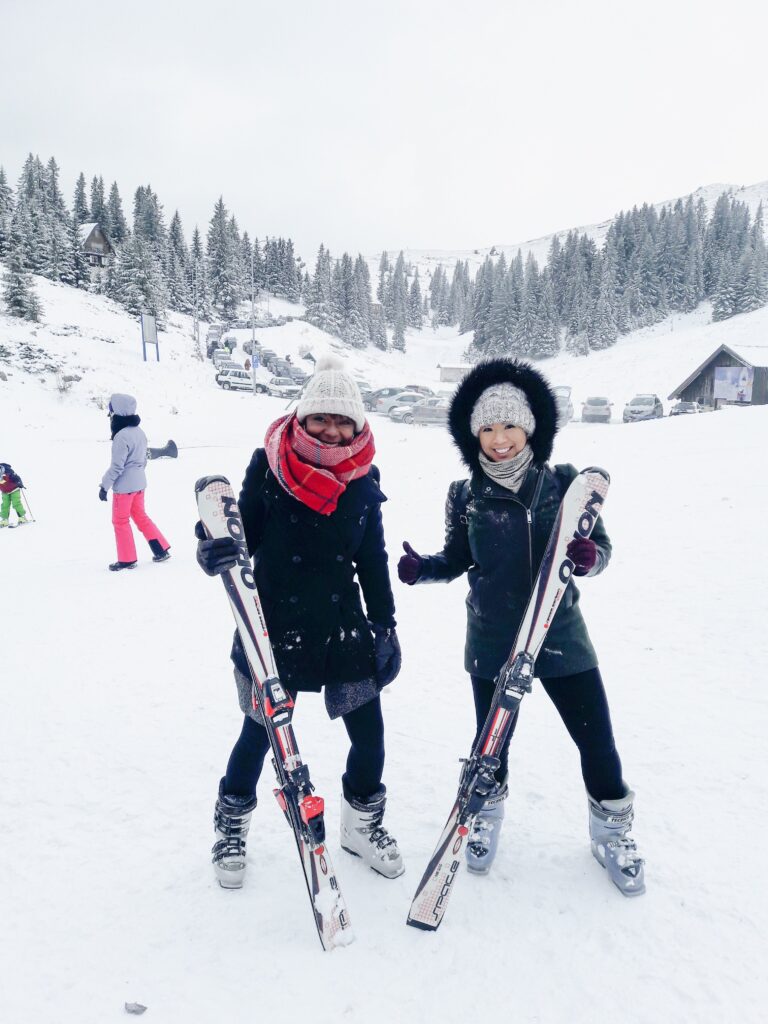
Skiing in Sarajevo, Bosnia and Herzegovina in wrong attire
So, there we were (my friend also made this grave assumption), on this Olympic mountain, freezing our buns off and I’m certain on the brink of hypothermia. Don’t be like me, be better than me. Do not compromise on your ski attire. Ever! You can be fashionable on the slopes, but also be sure your attire is functional and keeps you dry and warm. Also, layer layer LAYER!!!
What to Wear Skiing
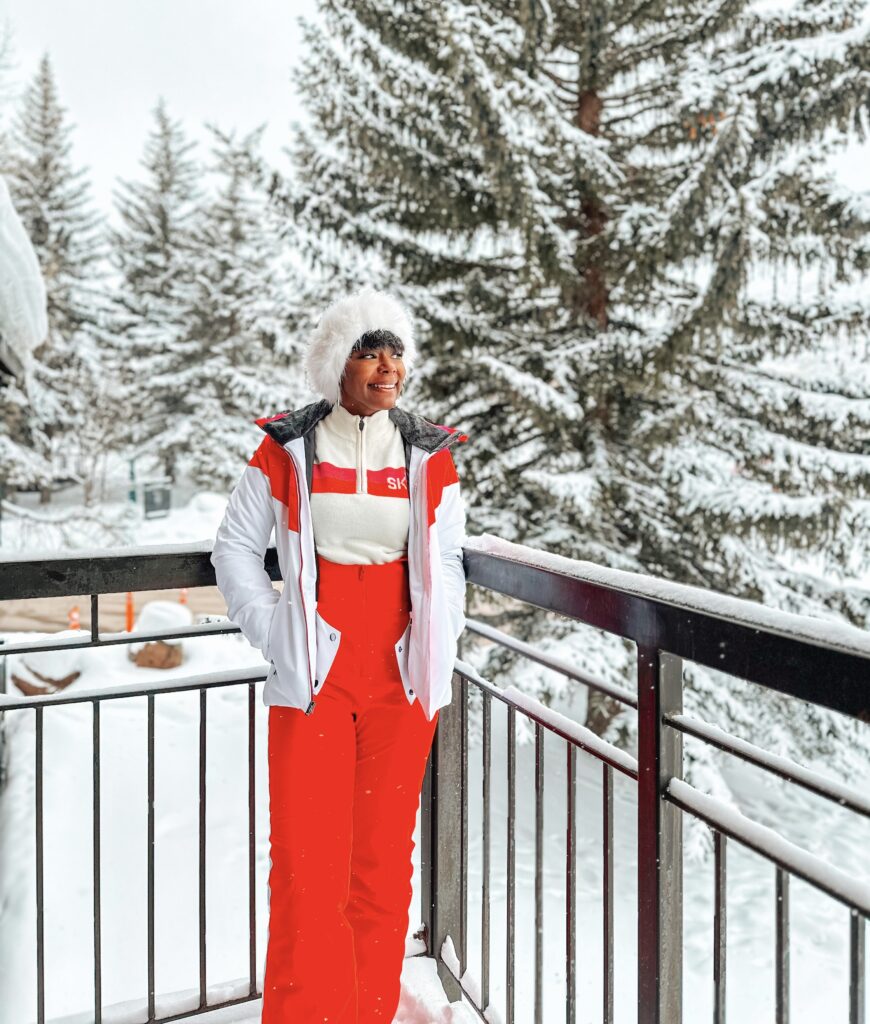
I cannot stress enough how important it is to wear proper attire for skiing. Staying warm, and staying dry are your top priorities, besides staying safe, of course. You will need ski clothes that do both, so that means no jeans and no leggings and peacoats (still can’t believe I did that).
When skiing, layering is key for staying warm and comfortable. You will absolutely be miserable if you are not dressed properly. So, start with a moisture-wicking base layer like Smartwool to keep sweat at bay. Add a cozy mid-layer for insulation, like a fleece jacket (I’m a fan of Magellan). For the outer layer, go with a waterproof, breathable ski jacket and pants. Ski jackets with “pit zips” are a game-changer! You can unzip the vents to help regulate your temperature.
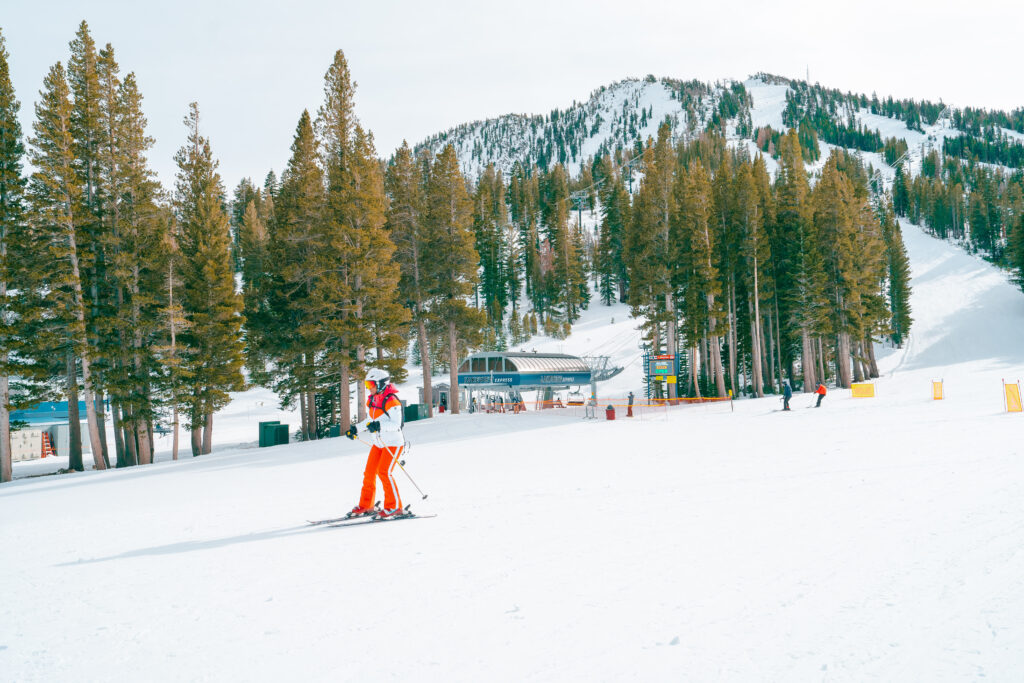
Don’t forget warm socks (preferably merino wool). Do not…I repeat DO NOT layer your socks (i.e. wearing more than one pair)! I used to do this because I thought it would provide more warmth, when in actuality, it caused my boots to be uncomfortable and would restrict blood flow; thus, cutting off my circulation, and making my feet even colder. One pair of merino wool socks and feet warmers is all you need. Also, your socks should be long, and not stop right on your shin where your boots have the potential to rub them. This causes unnecessary friction and is painful.
Waterproof, insulated gloves and a balaclava to protect your face from the cold wind are also a must. Top it all off with a helmet and goggles for safety and you’re good to go. Layering properly ensures you stay warm, dry, and ready to conquer the slopes!
Here are some Amazon links for your ski gear essentials:
- Smartwool Base Layer
- Fleece Mid Layer
- Waterproof Ski Jacket
- Waterproof Ski Pants
- Merino Wool Socks
- Ski Gloves
- Balaclava/Gaiter
- Ski Googles
- Feet Warmers
- Hand Warmers
Click here to See full list
3. Should I rent or buy equipment as a first-time skier?
I’m a big proponent of “try before you buy”, especially items that are a hefty investment — like skiing. As a first-time skier, I do not recommend going out and purchasing your gear. Skiing is not a cheap sport, so I highly recommend renting your skis, boots, pools, and even helmets when skiing for the first time. Renting these items on-site also means less of a hassle transporting the ski equipment.
4. Make sure your ski gear fits properly
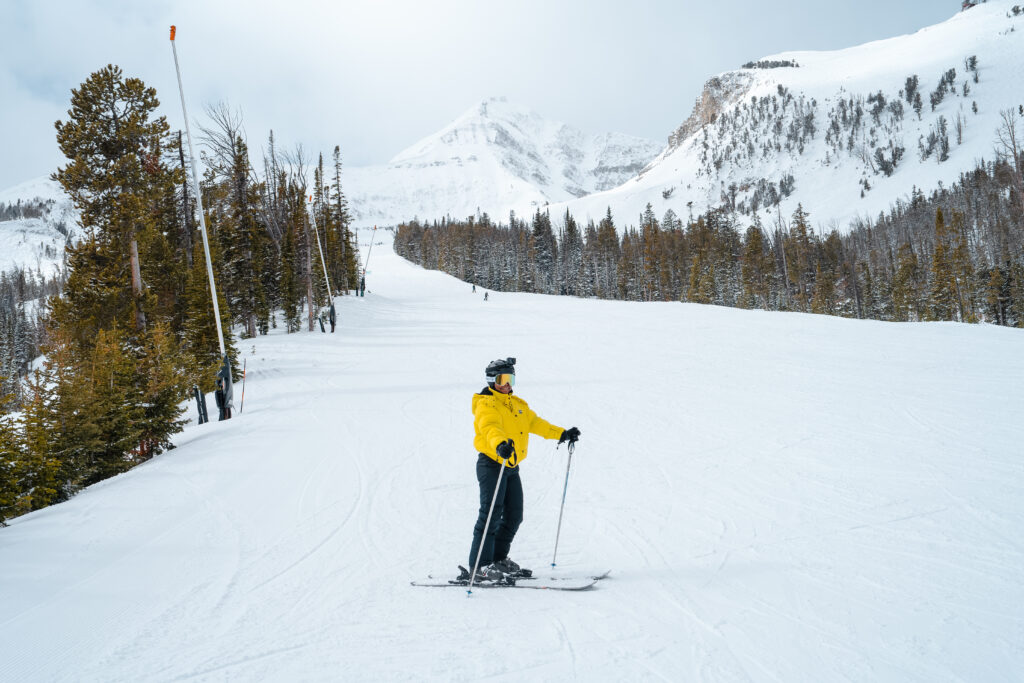
“How does that fit?”
If you are new to skiing and you’re renting your equipment, this is a question the associate, who’s fitting you for your gear, will inevitably ask you over and over. But, as a beginner skier, how are you supposed to know if it “fits right” or “feels right” if you’ve never worn ski gear? I’m here to help.
Your helmet should never be loose. Ever. It should fit snuggly and if it doesn’t, have them tighten it.
When it comes to ski boots, they are not comfortable….at all! It will take some getting used to walking in them. How do you know if your ski boots are fitting right? Personally, I have to go a 1/2 size up on my ski boots. Once, I made the mistake of getting the wrong size boots. They felt snug, but ok, when trying them on. But, when I hit the slopes, I quickly realized they were too small. My toes were cramped and felt annihilated after hours of skiing. I usually wear a 6.5 in shoes. I get a 7 in ski boots. Your boots should fit tight and snug, but never painful. Your toes should be just barely not touching the tips of your boot.
To determine the ski length, a general rule is for your skis to measure somewhere between your chin to the top of your head. Of course, an associate can always help you with this.
5. Buy Ski Googles beforehand
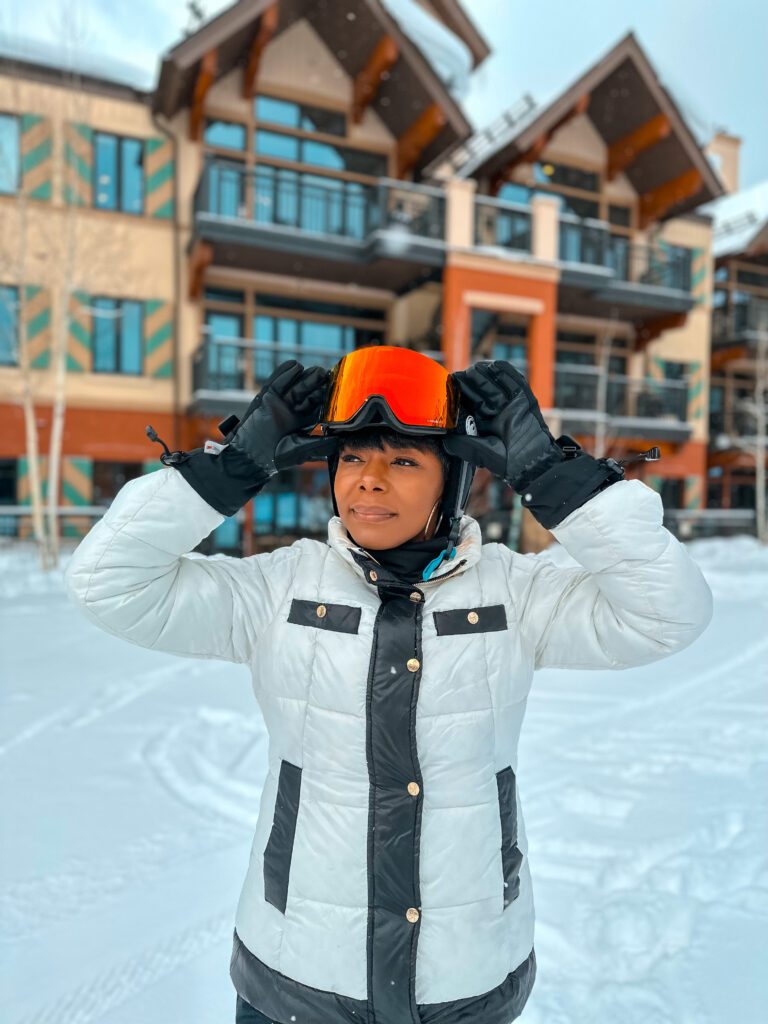
Skiing without goggles is a big NO! You need to protect your peepers from harmful UV rays, sun glares from the snow, wind, and debris. Sunglasses won’t do it. Snow goggles are a must! While you typically can’t rent goggles, as a beginner skier, you can find some pretty inexpensive ski goggles on Amazon.
Speaking of goggle colors…
They matter!! When choosing a pair of ski goggles to match that cute ski suit you bought for those Insta-shots, take into consideration the weather conditions you might be skiing in.

When in doubt, go with tints such as blue, red, and green as they are for all-purpose use and cover a range of conditions. If you don’t mind paying a little bit more for ski goggles, I highly recommend Dragon Alliance. I love that they have interchangeable lenses that allow you to swap out the lenses if the weather conditions change.
6. Don’t skip the sunscreen
Using sunscreen while skiing is super important. Yes — even for my melanated sisters and brothers. Use sunscreen with high SPF to protect against sunburn, even on those overcast days when the sun isn’t shining directly. Black Girl Sunscreen is my go-to — it doesn’t leave that annoying white cast after applying.
7. Take the lesson, sis!
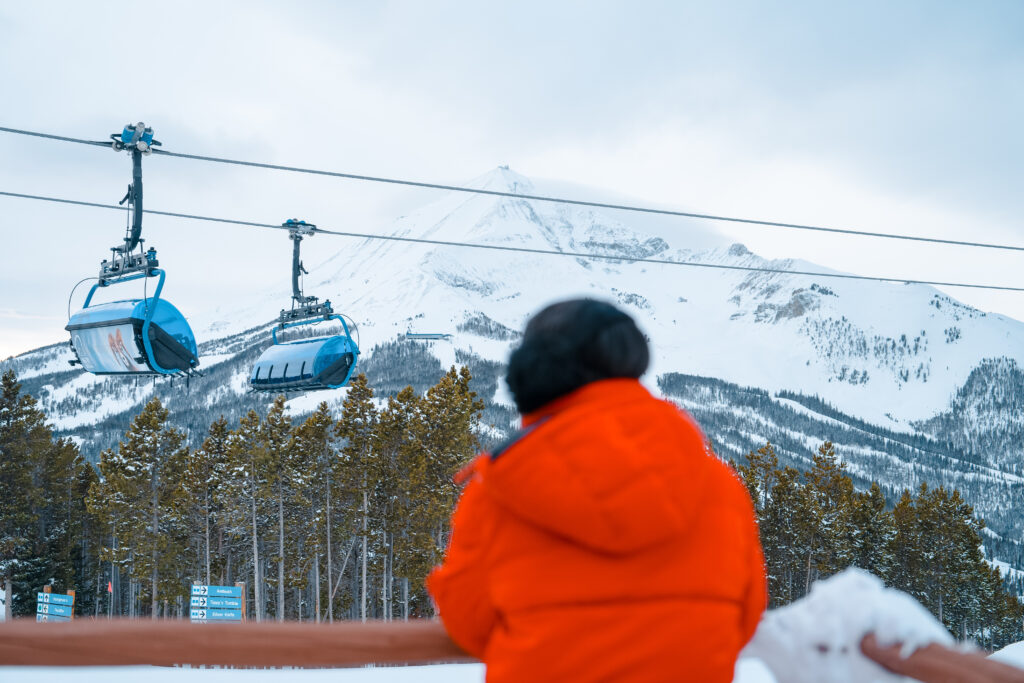
We all have to start somewhere and skiing is not one of those sports where you just head to the top of a mountain and figure it out as you go. As with any sport, it can be dangerous and you can severely harm yourself, so take a lesson with a certified instructor and learn at least the basics. It is often said that “skiing is easy to learn and hard to master.” I find this to be true. With three good days on the slopes, you’ll be amazed at how easy it is to advance in your skill set. But, it all starts with a proper lesson. I’ve always done group lessons which adds a more social/supportive vibe. But, if you prefer personalized attention go for the private lesson.
8. Ski with a friend
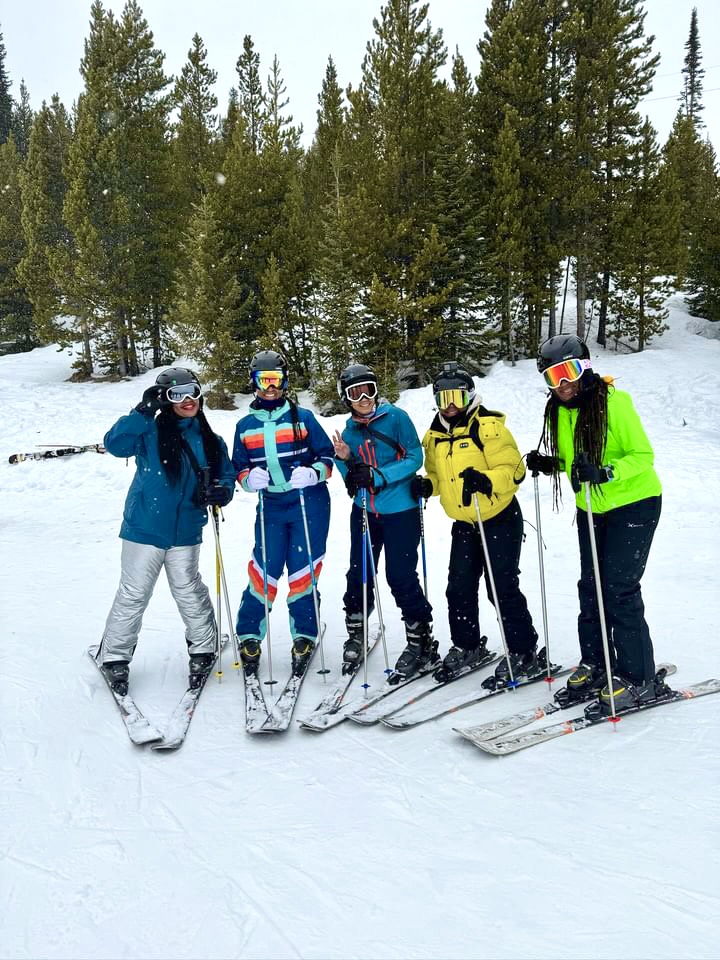
Skiing with a friend is always a win! Not only is it safer, but it makes the whole experience way more fun. You’ve got someone to share the laughs (and the wipeouts) with, plus it’s great to help each other out when needed. Before you hit the slopes, make sure you’ve got a few signals down — like a thumbs-up to say you’re good or a wave to call it a stop. That way, you’re both in sync, and your day on the mountain will be a blast! So, grab your bestie (old or new) and hit the snow together!
9. Take baby steps
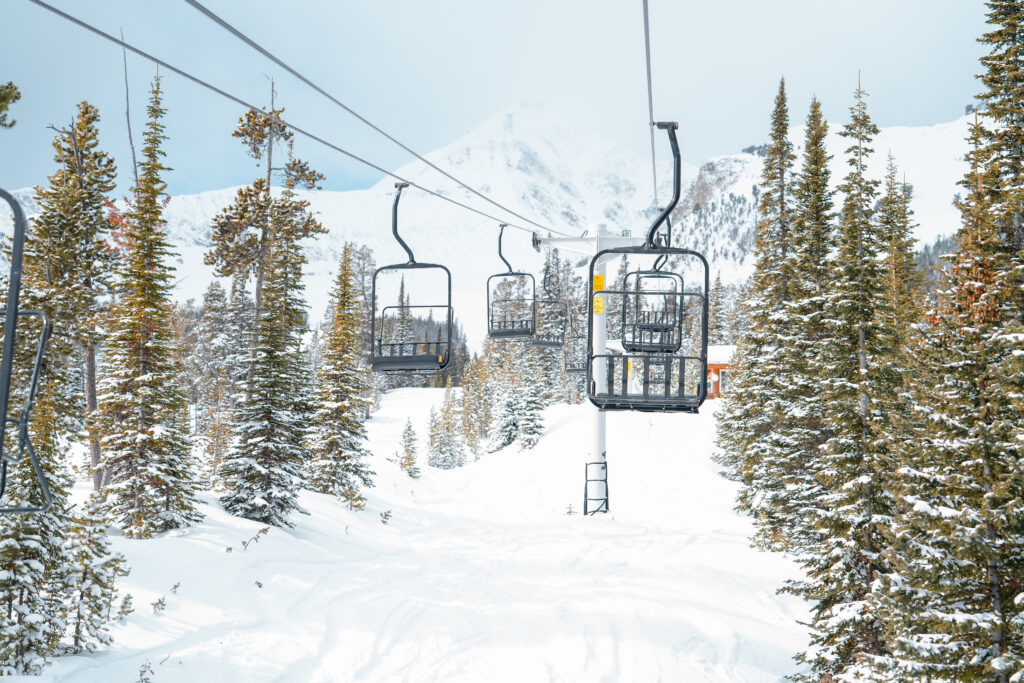
As a first-time skier, the beginner slopes (or bunny slopes as they are often referred to) will be your terrain domain. These are the easiest slopes (more like small hills) for first-time skiers. You always want to make sure you are choosing the right terrain for your skillset. Here’s the breakdown:
Green Trails (Easiest): Start your journey as a beginner skier
Blue Trails (More Difficult): Elevate your skills on blue trails
Black Trails (Most Difficult): Save the black trails for when you become a skiing maestro
Know your colors, know your limits. Also, all slopes are not created equal. Case and point…green slopes in Whistler, Canada were more like blue slopes. I quickly realized this during a guided ski tour and knew I didn’t feel comfortable skiing down those steep slopes, so this meant having to trek back up the mountain with skies in hand because that was the only way off the mountain, besides skiing down, which was not an option for me, if I wanted to keep my life and limbs.
click here to read more about my luxury winter getaway in Whistler
10. Altitude Sickness is a Thing
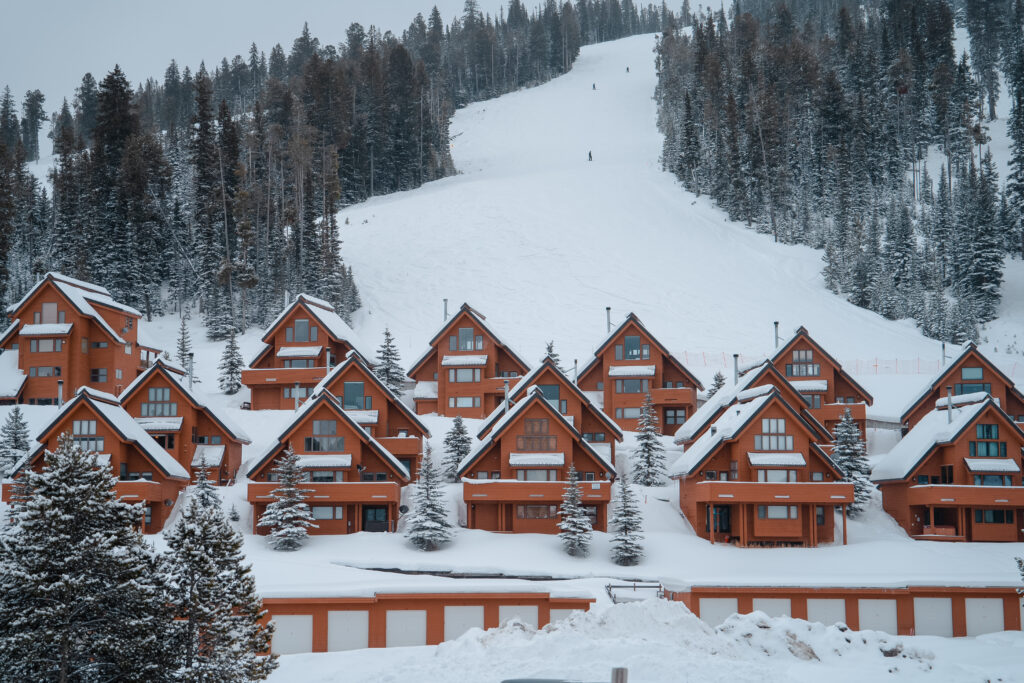
Altitude sickness is a real thing when you’re skiing at high elevations – think headaches, nausea, insomnia (my first night in Snowmass, CO I didn’t sleep the entire night due to altitude insomnia), and dizziness. It happens because the air is thinner up there. To fight it, drink plenty of water (no, not just apres-ski drinks!), mind your alcohol intake (you’ll feel tipsy much quicker, so pace yourself), and take it slow on your first day. Give yourself time to adjust to the altitude before hitting those steep slopes. Your body will thank you!
Pin it for later!
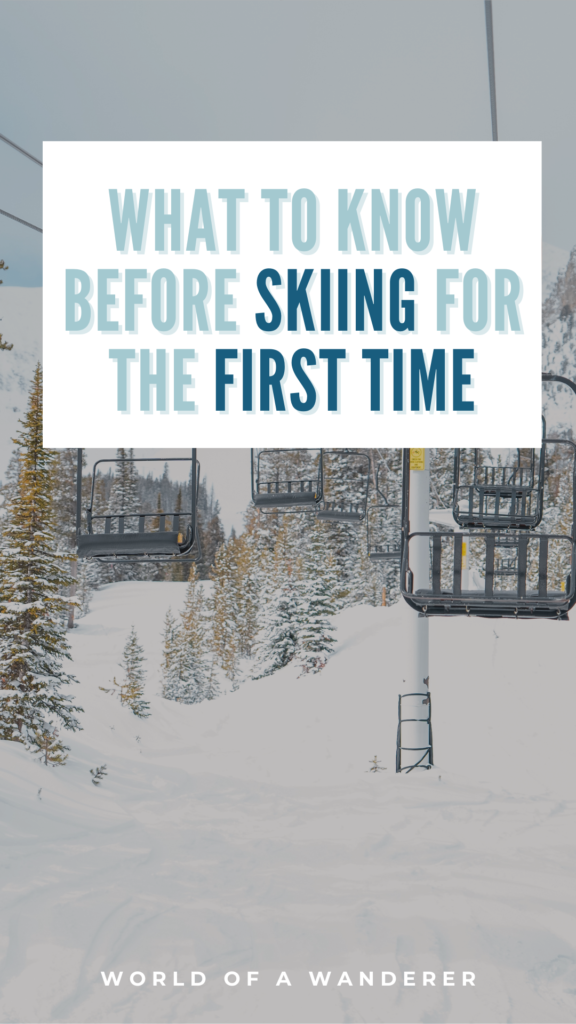
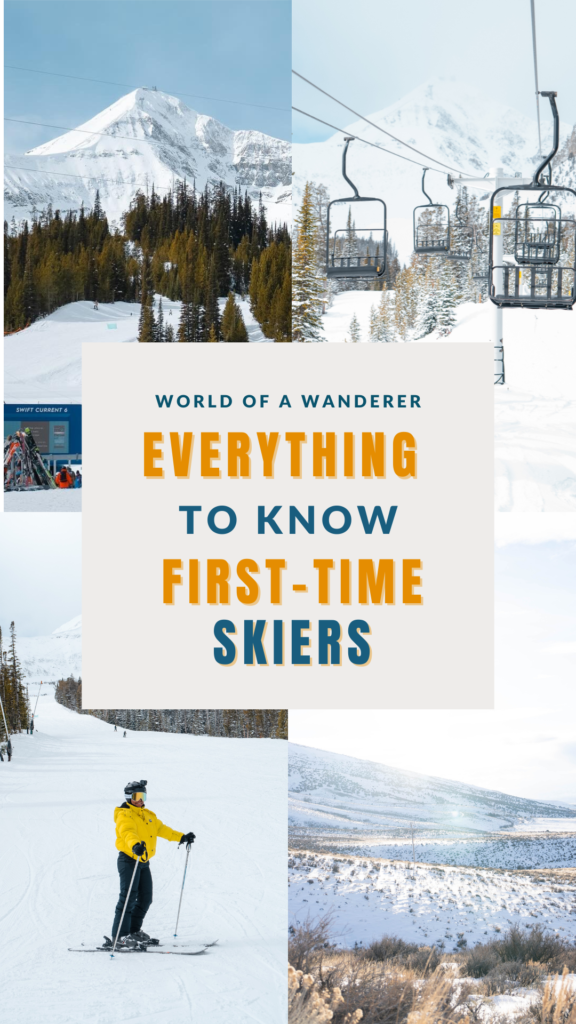




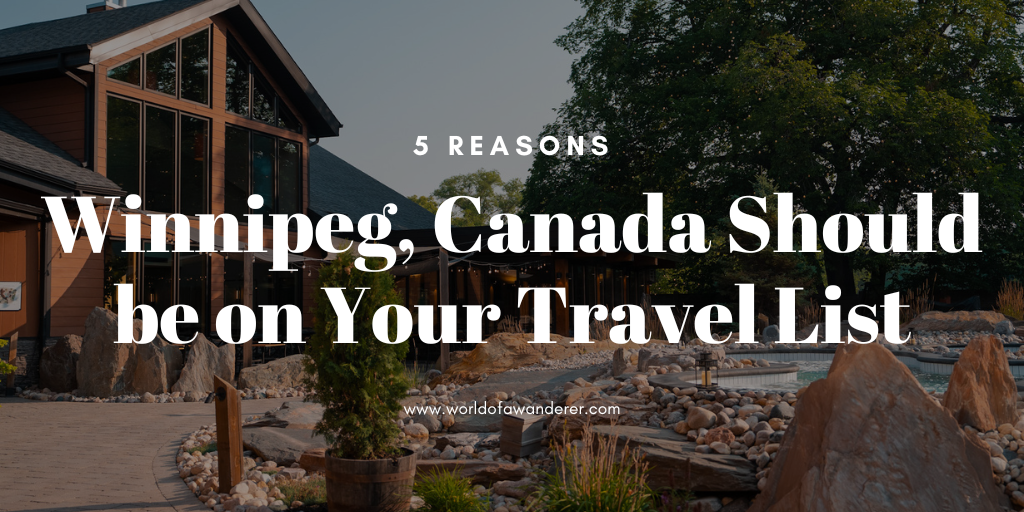


tita
Very good article thanks so much for the information
GTU